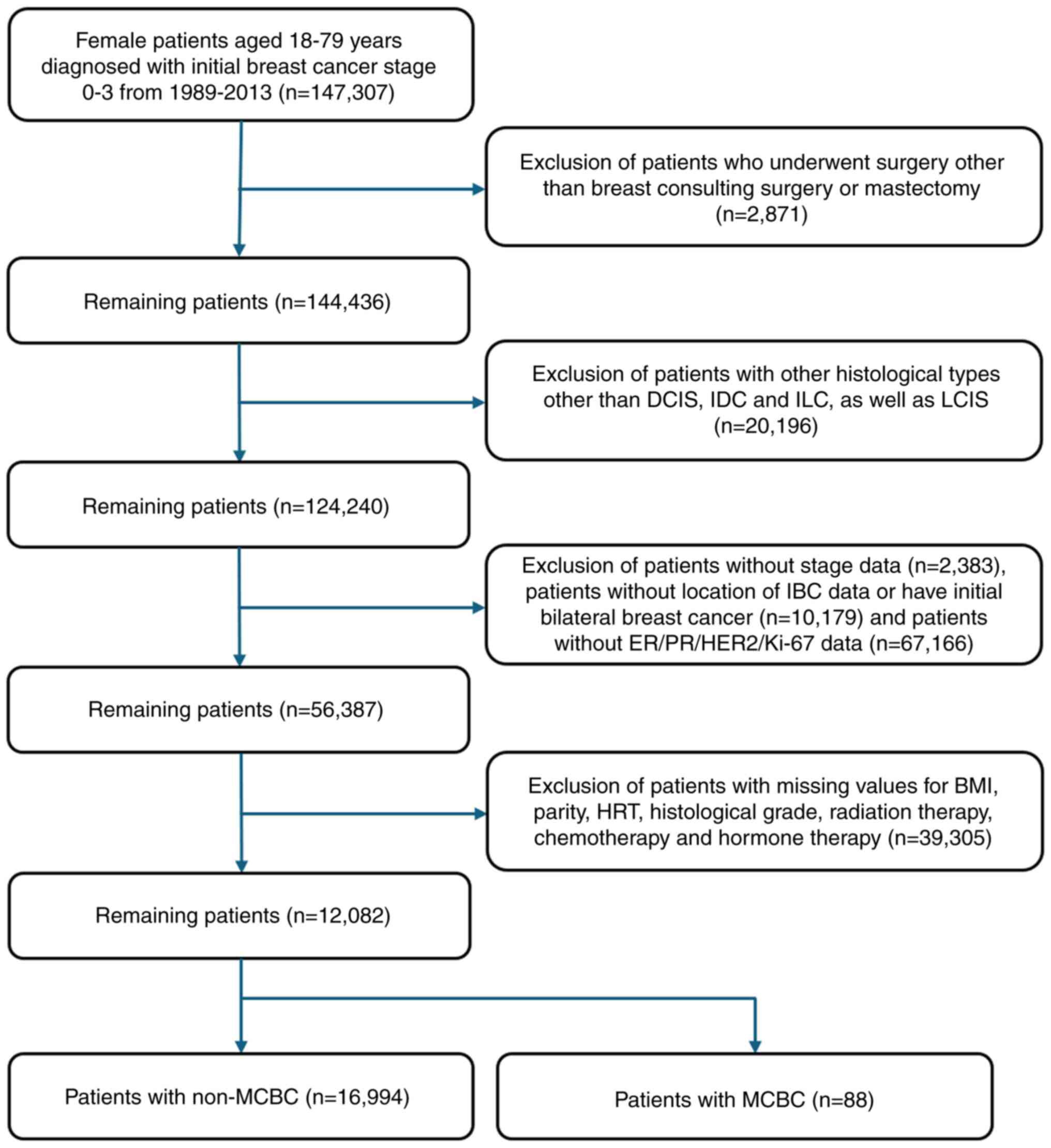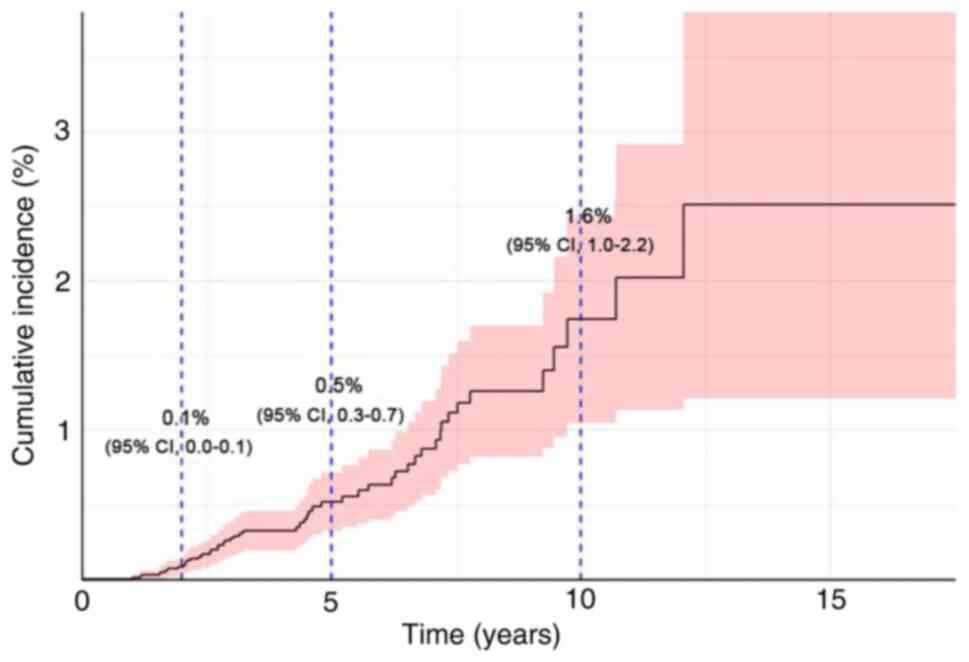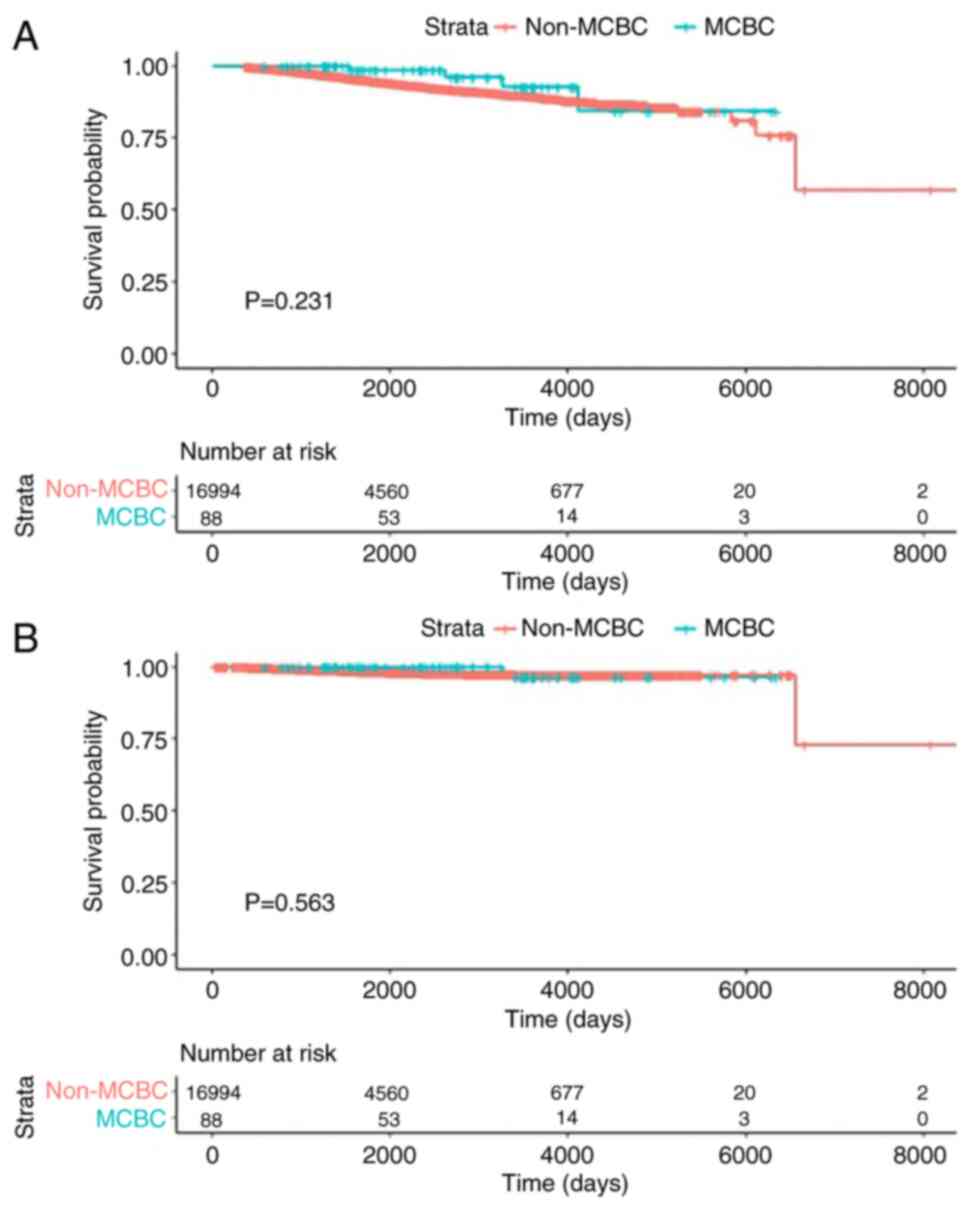|
1
|
Hartman M, Czene K, Reilly M, Adolfsson J,
Bergh J, Adami HO, Dickman PW and Hall P: Incidence and prognosis
of synchronous and metachronous bilateral breast cancer. J Clin
Oncol. 25:4210–4216. 2007. View Article : Google Scholar : PubMed/NCBI
|
|
2
|
Nichols HB, Berrington de González A,
Lacey JV Jr, Rosenberg PS and Anderson WF: Declining incidence of
contralateral breast cancer in the United States from 1975 to 2006.
J Clin Oncol. 29:1564–1569. 2011. View Article : Google Scholar : PubMed/NCBI
|
|
3
|
Rosen PP, Groshen S, Kinne DW and Hellman
S: Contralateral breast carcinoma: An assessment of risk and
prognosis in stage I (T1N0M0) and stage II (T1N1M0) patients with
20-year follow-up. Surgery. 106:904–910. 1989.PubMed/NCBI
|
|
4
|
Hankey BF, Curtis RE, Naughton MD, Boice
JD Jr and Flannery JT: A retrospective cohort analysis of second
breast cancer risk for primary breast cancer patients with an
assessment of the effect of radiation therapy. J Natl Cancer Inst.
70:797–804. 1983.PubMed/NCBI
|
|
5
|
Reiner AS, John EM, Brooks JD, Lynch CF,
Bernstein L, Mellemkjær L, Malone KE, Knight JA, Capanu M, Teraoka
SN, et al: Risk of asynchronous contralateral breast cancer in
noncarriers of BRCA1 and BRCA2 mutations with a family history of
breast cancer: A report from the Women's environmental cancer and
radiation epidemiology study. J Clin Oncol. 31:433–439. 2013.
View Article : Google Scholar : PubMed/NCBI
|
|
6
|
Bernstein JL, Thompson WD, Risch N and
Holford TR: Risk factors predicting the incidence of second primary
breast cancer among women diagnosed with a first primary breast
cancer. Am J Epidemiol. 136:925–936. 1992. View Article : Google Scholar : PubMed/NCBI
|
|
7
|
Bertelsen L, Bernstein L, Olsen JH,
Mellemkjaer L, Haile RW, Lynch CF, Malone KE, Anton-Culver H,
Christensen J, Langholz B, et al: Effect of systemic adjuvant
treatment on risk for contralateral breast cancer in the Women's
Environment, Cancer and Radiation Epidemiology Study. J Natl Cancer
Inst. 100:32–40. 2008. View Article : Google Scholar : PubMed/NCBI
|
|
8
|
Early Breast Cancer Trialists'
Collaborative Group (EBCTCG), : Effects of chemotherapy and
hormonal therapy for early breast cancer on recurrence and 15-year
survival: An overview of the randomised trials. Lancet.
365:1687–1717. 2005. View Article : Google Scholar : PubMed/NCBI
|
|
9
|
Davies C, Pan H, Godwin J, Gray R,
Arriagada R, Raina V, Abraham M, Medeiros Alencar VH, Badran A,
Bonfill X, et al: Long-term effects of continuing adjuvant
tamoxifen to 10 years versus stopping at 5 years after diagnosis of
oestrogen receptor-positive breast cancer: ATLAS, a randomised
trial. Lancet. 381:805–816. 2013. View Article : Google Scholar : PubMed/NCBI
|
|
10
|
Kilgore AR: The incidence of cancer in the
second breast: After radical removal of one breast for cancer. J Am
Med Assoc. 77:454–457. 1921. View Article : Google Scholar
|
|
11
|
Haagensen CD and Rosato FE: Diseases of
the breast. Ann Surg. 176:6901972. View Article : Google Scholar
|
|
12
|
Prior P and Waterhouse JA: Incidence of
bilateral tumours in a population-based series of breast-cancer
patients. I. Two approaches to an epidemiological analysis. Br J
Cancer. 37:620–634. 1978. View Article : Google Scholar : PubMed/NCBI
|
|
13
|
Healey EA, Cook EF, Orav EJ, Schnitt SJ,
Connolly JL and Harris JR: Contralateral breast cancer: Clinical
characteristics and impact on prognosis. J Clin Oncol.
11:1545–1552. 1993. View Article : Google Scholar : PubMed/NCBI
|
|
14
|
Intra M, Rotmensz N, Viale G, Mariani L,
Bonanni B, Mastropasqua MG, Galimberti V, Gennari R, Veronesi P,
Colleoni M, et al: Clinicopathologic characteristics of 143
patients with synchronous bilateral invasive breast carcinomas
treated in a single institution. Cancer. 101:905–912. 2004.
View Article : Google Scholar : PubMed/NCBI
|
|
15
|
de la Rochefordiere A, Asselain B, Scholl
S, Campana F, Ucla L, Vilcoq JR, Durand JC, Pouillart P and
Fourquet A: Simultaneous bilateral breast carcinomas: A
retrospective review of 149 cases. Int J Radiat Oncol Biol Phys.
30:35–41. 1994. View Article : Google Scholar : PubMed/NCBI
|
|
16
|
Al-Jurf AS, Jochimsen PR, Urdaneta LF and
Scott DH: Factors influencing survival in bilateral breast cancer.
J Surg Oncol. 16:343–348. 1981. View Article : Google Scholar : PubMed/NCBI
|
|
17
|
Heron DE, Komarnicky LT, Hyslop T,
Schwartz GF and Mansfield CM: Bilateral breast carcinoma: Risk
factors and outcomes for patients with synchronous and metachronous
disease. Cancer. 88:2739–2750. 2000. View Article : Google Scholar : PubMed/NCBI
|
|
18
|
Quan G, Pommier SJ and Pommier RF:
Incidence and outcomes of contralateral breast cancers. Am J Surg.
195:645–650; discussion 650. 2008. View Article : Google Scholar : PubMed/NCBI
|
|
19
|
Londero AP, Bernardi S, Bertozzi S,
Angione V, Gentile G, Dri C, Minucci A, Caponnetto F and Petri R:
Synchronous and metachronous breast malignancies: A cross-sectional
retrospective study and review of the literature. Biomed Res Int.
2014:2507272014. View Article : Google Scholar : PubMed/NCBI
|
|
20
|
Begg CB, Ostrovnaya I, Geyer FC,
Papanastasiou AD, Ng CKY, Sakr RA, Bernstein JL, Burke KA, King TA,
Piscuoglio S, et al: Contralateral breast cancers: Independent
cancers or metastases. Int J Cancer. 142:347–356. 2018. View Article : Google Scholar : PubMed/NCBI
|
|
21
|
Hamy AS, Abécassis J, Driouch K, Darrigues
L, Vandenbogaert M, Laurent C, Zaccarini F, Sadacca B, Delomenie M,
Laas E, et al: Evolution of synchronous female bilateral breast
cancers and response to treatment. Nat Med. 29:646–655. 2023.
View Article : Google Scholar : PubMed/NCBI
|
|
22
|
Al Saad S, Al Shenawi H, Almarabheh A, Al
Shenawi N, Mohamed AI and Yaghan R: Is laterality in breast Cancer
still worth studying? Local experience in Bahrain. BMC Cancer.
22:9682022. View Article : Google Scholar : PubMed/NCBI
|
|
23
|
Abdou Y, Gupta M, Asaoka M, Attwood K,
Mateusz O, Gandhi S and Takabe K: Left sided breast cancer is
associated with aggressive biology and worse outcomes than right
sided breast cancer. Sci Rep. 12:133772022. View Article : Google Scholar : PubMed/NCBI
|
|
24
|
Edge SB and Compton CC: The American Joint
Committee on Cancer: The 7th edition of the AJCC cancer staging
manual and the future of TNM. Ann Surg Oncol. 17:1471–1474. 2010.
View Article : Google Scholar : PubMed/NCBI
|
|
25
|
Wolff AC, Somerfield MR, Dowsett M,
Hammond MEH, Hayes DF, McShane LM, Saphner TJ, Spears PA and
Allison KH: Human epidermal growth factor receptor 2 testing in
breast cancer: ASCO-college of american pathologists guideline
update. J Clin Oncol. 41:3867–3872. 2023. View Article : Google Scholar : PubMed/NCBI
|
|
26
|
Song F, Li X, Song F, Zhao Y, Li H, Zheng
H, Gao Z, Wang J, Zhang W and Chen K: Comparative genomic analysis
reveals bilateral breast cancers are genetically independent.
Oncotarget. 6:31820–31829. 2015. View Article : Google Scholar : PubMed/NCBI
|
|
27
|
Kim BK, Choi JE, Youn HJ, Park HS, Kim D,
Oh SJ, Lee HJ, Lee J and Sun WY; Korean Breast Cancer Society, :
Clinicopathological features and prognosis associated with breast
cancer laterality: A nationwide study from the Korean Breast Cancer
Society. Ann Surg Treat Res. 103:119–128. 2022. View Article : Google Scholar : PubMed/NCBI
|
|
28
|
Pan B, Xu Y, Zhou YD, Yao R, Wu HW, Zhu
QL, Wang CJ, Mao F, Lin Y, Shen SJ and Sun Q: The prognostic
comparison among unilateral, bilateral, synchronous bilateral, and
metachronous bilateral breast cancer: A meta-analysis of studies
from recent decade (2008–2018). Cancer Med. 8:2908–2918. 2019.
View Article : Google Scholar : PubMed/NCBI
|
|
29
|
Kim H, Yoon TI, Kim S, Lee SB, Kim J,
Chung IY, Ko BS, Lee JW, Son BH, Gwark S, et al: Survival after
development of contralateral breast cancer in Korean patients with
breast cancer. JAMA Netw Open. 6:e23335572023. View Article : Google Scholar : PubMed/NCBI
|
|
30
|
Austin PC and Fine JP: Practical
recommendations for reporting Fine-Gray model analyses for
competing risk data. Stat Med. 36:4391–4400. 2017. View Article : Google Scholar : PubMed/NCBI
|
|
31
|
Zhang Z: Survival analysis in the presence
of competing risks. Ann Transl Med. 5:472017. View Article : Google Scholar : PubMed/NCBI
|
|
32
|
Broët P, de la Rochefordière A, Scholl SM,
Fourquet A, Mosseri V, Durand JC, Pouillart P and Asselain B:
Contralateral breast cancer: Annual incidence and risk parameters.
J Clin Oncol. 13:1578–1583. 1995. View Article : Google Scholar : PubMed/NCBI
|
|
33
|
Gao X, Fisher SG and Emami B: Risk of
second primary cancer in the contralateral breast in women treated
for early-stage breast cancer: A population-based study. Int J
Radiat Oncol Biol Phys. 56:1038–1045. 2003. View Article : Google Scholar : PubMed/NCBI
|












